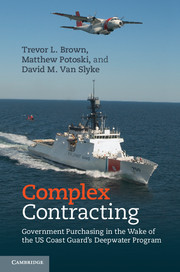Book contents
- Frontmatter
- Contents
- List of figure and tables
- Foreword
- 1 Introduction: the promise and perils of government contracting
- 2 Managing complex contracting in theory and practice
- 3 The Coast Guard’s Deepwater program
- 4 Rules in complex contracts
- 5 Performance incentives in complex contracts
- 6 Complex contracting’s promise and pitfalls: win-win and lose-lose
- 7 Management strategies for complex contracts
- References
- Index
3 - The Coast Guard’s Deepwater program
Published online by Cambridge University Press: 05 August 2013
- Frontmatter
- Contents
- List of figure and tables
- Foreword
- 1 Introduction: the promise and perils of government contracting
- 2 Managing complex contracting in theory and practice
- 3 The Coast Guard’s Deepwater program
- 4 Rules in complex contracts
- 5 Performance incentives in complex contracts
- 6 Complex contracting’s promise and pitfalls: win-win and lose-lose
- 7 Management strategies for complex contracts
- References
- Index
Summary
SEARCH AND RESCUE
On the morning of February 28, 2009, four friends set out of harbor from Clearwater, Florida, in a 21-foot boat and anchored 70 miles offshore for a day of fishing. When they decided to head home, they found that their anchor was stuck. Believing that a hard tug would set them free, they secured the anchor line to the stern and pushed up the throttle. But instead of dislodging the anchor, the accelerating motor submerged the stern and the boat began taking on water and capsized just seconds later, tossing the friends into the Gulf waters. The friends were a remarkable group of athletes, though none was an experienced boater. Two of them played professional football: Marquis Cooper was a linebacker for the National Football League’s (NFL) Oakland Raiders and Corey Smith was a defensive end with the Detroit Lions. The other two, William Bleakley and Nick Schulyer, played football in college for the University of South Florida.
The four boaters dove under the upturned boat to retrieve what they could. They brought up a few life vests but were unable to get any food or water. They were without a Global Positioning System (GPS) device, and while they had cell phones, they were too far away from shore to pick up service. The water temperature hovered around 65 degrees Fahrenheit. Treading water, the four friends were at risk of hypothermia, dehydration, starvation, and predation from sharks.
Information
- Type
- Chapter
- Information
- Complex ContractingGovernment Purchasing in the Wake of the US Coast Guard's Deepwater Program, pp. 57 - 106Publisher: Cambridge University PressPrint publication year: 2013
